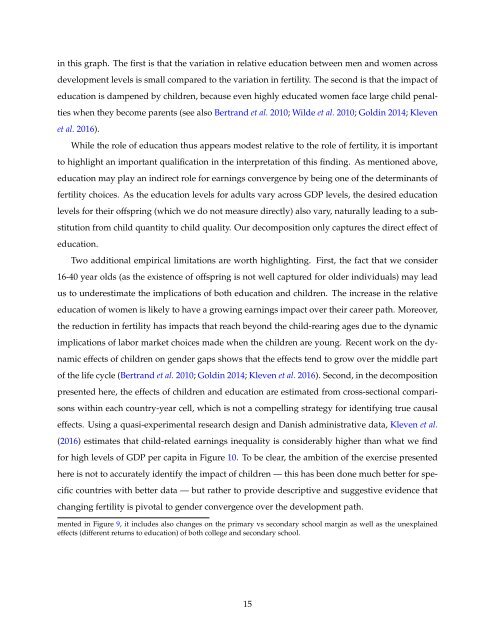Gender Inequality and Economic Development Fertility Education and Norms
kleven-landais_economica_jan2017
kleven-landais_economica_jan2017
You also want an ePaper? Increase the reach of your titles
YUMPU automatically turns print PDFs into web optimized ePapers that Google loves.
in this graph. The first is that the variation in relative education between men <strong>and</strong> women across<br />
development levels is small compared to the variation in fertility. The second is that the impact of<br />
education is dampened by children, because even highly educated women face large child penalties<br />
when they become parents (see also Bertr<strong>and</strong> et al. 2010; Wilde et al. 2010; Goldin 2014; Kleven<br />
et al. 2016).<br />
While the role of education thus appears modest relative to the role of fertility, it is important<br />
to highlight an important qualification in the interpretation of this finding. As mentioned above,<br />
education may play an indirect role for earnings convergence by being one of the determinants of<br />
fertility choices. As the education levels for adults vary across GDP levels, the desired education<br />
levels for their offspring (which we do not measure directly) also vary, naturally leading to a substitution<br />
from child quantity to child quality. Our decomposition only captures the direct effect of<br />
education.<br />
Two additional empirical limitations are worth highlighting. First, the fact that we consider<br />
16-40 year olds (as the existence of offspring is not well captured for older individuals) may lead<br />
us to underestimate the implications of both education <strong>and</strong> children. The increase in the relative<br />
education of women is likely to have a growing earnings impact over their career path. Moreover,<br />
the reduction in fertility has impacts that reach beyond the child-rearing ages due to the dynamic<br />
implications of labor market choices made when the children are young. Recent work on the dynamic<br />
effects of children on gender gaps shows that the effects tend to grow over the middle part<br />
of the life cycle (Bertr<strong>and</strong> et al. 2010; Goldin 2014; Kleven et al. 2016). Second, in the decomposition<br />
presented here, the effects of children <strong>and</strong> education are estimated from cross-sectional comparisons<br />
within each country-year cell, which is not a compelling strategy for identifying true causal<br />
effects. Using a quasi-experimental research design <strong>and</strong> Danish administrative data, Kleven et al.<br />
(2016) estimates that child-related earnings inequality is considerably higher than what we find<br />
for high levels of GDP per capita in Figure 10. To be clear, the ambition of the exercise presented<br />
here is not to accurately identify the impact of children — this has been done much better for specific<br />
countries with better data — but rather to provide descriptive <strong>and</strong> suggestive evidence that<br />
changing fertility is pivotal to gender convergence over the development path.<br />
mented in Figure 9, it includes also changes on the primary vs secondary school margin as well as the unexplained<br />
effects (different returns to education) of both college <strong>and</strong> secondary school.<br />
15


